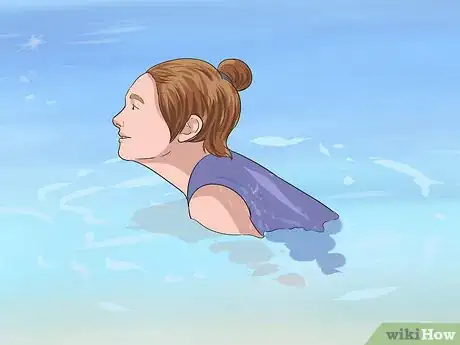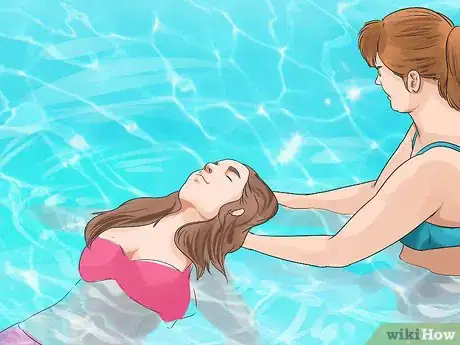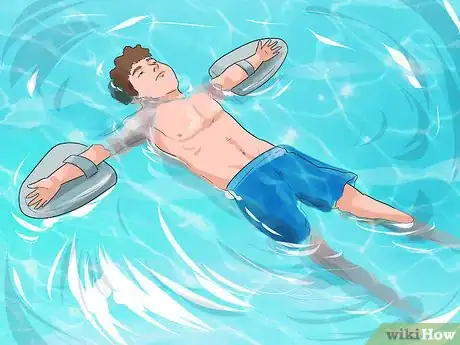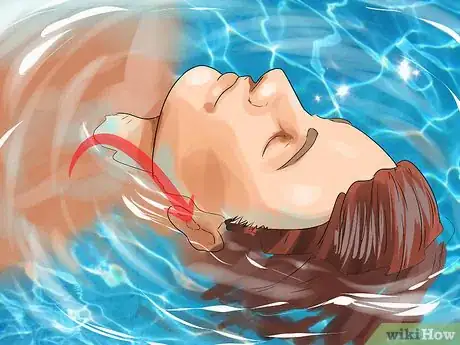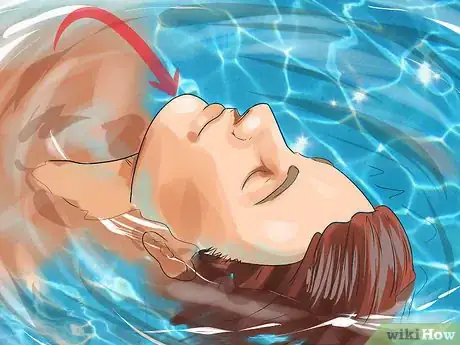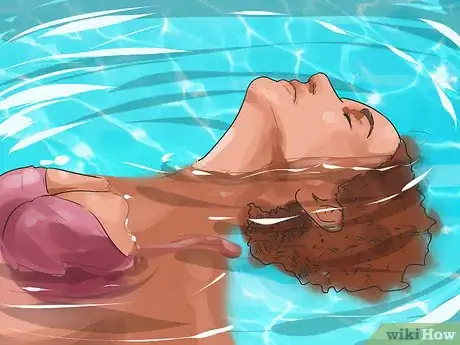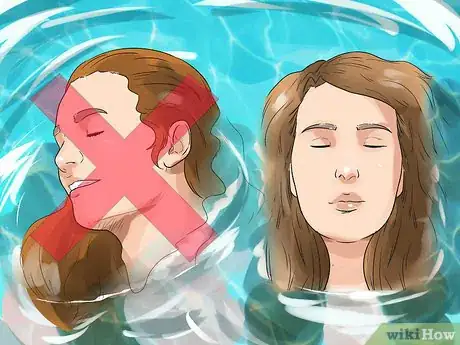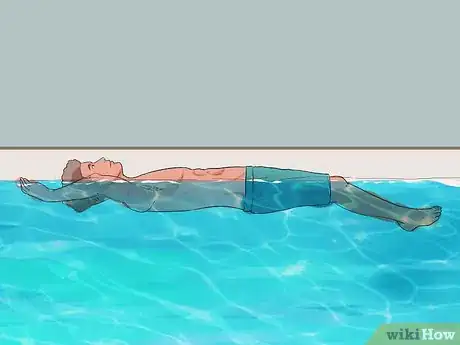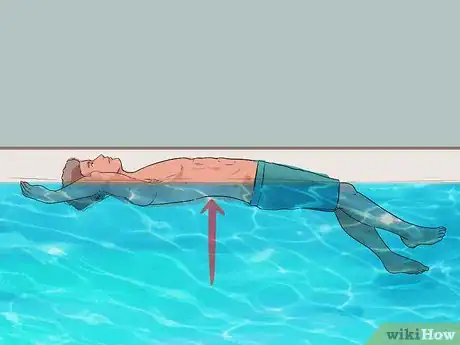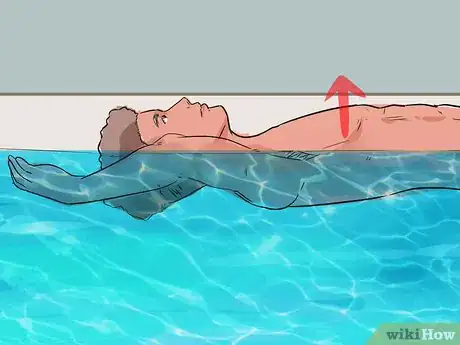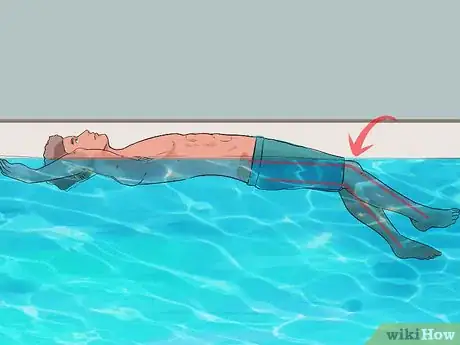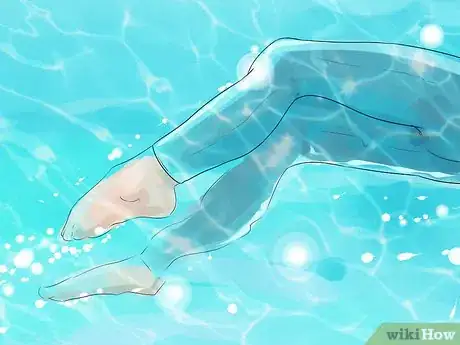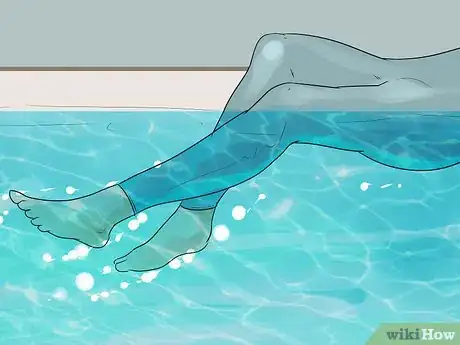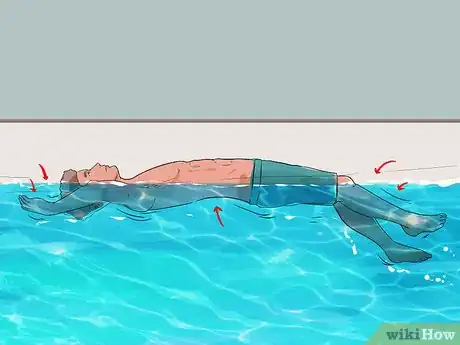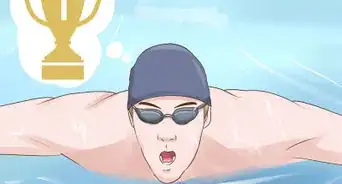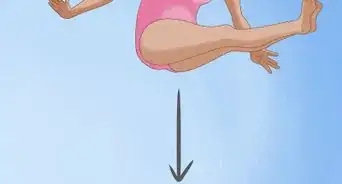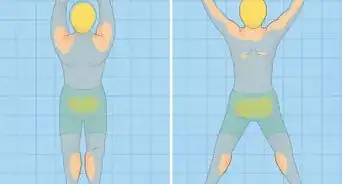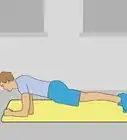This article was co-authored by Brad Hurvitz. Brad Hurvitz is a Certified Swimming Instructor for My Baby Swims, an adolescent swimming school based in La Jolla, California. Brad is trained as an Infant Swimming Resource (ISR) instructor with ISR's Self-Rescue® program. He specializes in training children aged six months to six years of age survival skills like floating on their back to breathe and swimming back to the wall, while also educating parents on how to better keep their kids safe. He has a Master of Business Administration from Oregon State University.
wikiHow marks an article as reader-approved once it receives enough positive feedback. This article received 12 testimonials and 100% of readers who voted found it helpful, earning it our reader-approved status.
This article has been viewed 553,163 times.
Floating on your back is a great way to get more comfortable in the water and to have fun relaxing on your back without the full effort of swimming. To float on your back, you have to position your head, upper body, and lower body correctly. Not only is floating on your back a great trick to add to your swimming repertoire, but it's a key safety technique if you're stranded in a body of water. If you fall in water by If you want to learn how to float on your back and to enjoy your time in the water even more, just read the following steps.
Steps
Preparing to Float on Your Back
-
1Be comfortable in the water. To be able to float on your back without panicking, you should be calm and relaxed in the water, even if you're not an expert swimmer. You should learn how to float on your back in a swimming pool, not an ocean or a lake with waves. Ideally, you should be reasonably comfortable in water and know how to swim from one end of a pool to the other without needing any help.[1]
- If you're floating on your back as a way to learn how to swim, then you should take extra caution and be with your spotter at all times.
-
2Get a spotter. Don't try to float on your back by yourself for the first time. Even if you've mastered other basic swimming techniques, if it's your first time trying to float on your back, you should not only have a spotter, but make sure that you're in a place with a lifeguard that can come to your rescue if you need the help.
- The spotter will place his hand under your back and will let you make the necessary adjustments to your body until you're comfortable trying the technique on your own.[2]
Advertisement -
3Try using a flotation device. Using a PFD (personal flotation device) around your arms or mid-section can also make you get more comfortable in the water. If you've worked with a spotter but aren't quite ready to try floating on your back on your own, try wearing the device until you wean yourself off of it.
-
4Align your body with the surface of the water. Before you begin to float on your back on your own, you need to align your body with the water -- ideally, your body should start off in a position that is almost parallel to the water or bottom of the pool. You can even get on your back and kick off the side of the pool until your body naturally glides with the surface of the water.
- Once your body is aligned with the surface of the water and your back is relatively parallel to the water, it'll be much easier to make adjustments to the rest of your body.
Adjusting Your Head
-
1Place your ears in the water. Though it may not feel comfortable to place your ears in the water at first, just tip back your head until your ears are completely submerged. If your ears are out of the water, it means that your neck will be straining and that your body will be able to float less easily.
-
2Lift your chin. Once your ears are submerged, lift your chin. You can lift it slightly, just an inch or two out of the water, or even lift it much more, so that it's pointing up toward the ceiling or sky. This will help you tip back your head and will make your entire body more buoyant.
-
3Make sure the water line is at mid-cheek. As you place your ears underwater and begin to lift your chin, make sure that the water line is at mid-cheek. It may be slightly lower if you raise your chin more dramatically.
-
4Stay centered. Keep your head centered so you don't tilt to one side or the other. Keeping your head centered will keep the rest of your body centered.
Adjusting Your Body
-
1Position your arms correctly. There are a few ways to position your arms when you're floating on your back. If you're an absolute beginner, you can bend your arms at the elbows and place your palms under your head as if you were doing a sit-up, and then bend your elbows back to force your body to tilt upwards even more.[3] Here are some other things to try as you position your arms:
- If you're more comfortable in the water, you can move your arms straight behind your head, mimicking the diving position, which will change your center of buoyancy and will balance out the weight of your legs more.
- You can also move your arms straight out or even keep them just a few inches away from your sides.
- Whatever you do with your arms, make sure that your palms are always facing the ceiling or sky.
-
2Arch your back slightly. This will help you tilt your body upward. Just arch your upper back a few inches upward.
-
3Lift your chest. As you arch your back, lift up your chest more so it's out of the water.
-
4Lift your stomach. You should also actively lift your stomach until your mid-section breaks the surface of the water.
-
5Bend your knees. Bend your knees to open up your legs a bit. If your legs are completely straight, you'll be more likely to sink.
-
6Let your legs dangle down. After you bend your knees, let your legs dangle down on either side, with at least a few feet of space between them. Your legs won't naturally float to the top of the water. For many adults, the legs are heavier than the arms and upper body, so the legs may naturally float downward.[4] This may be different for small children, who don't have muscular legs.
-
7Kick your legs (if necessary). If you do feel your body floating downward near your legs, just take small kicks with your legs to keep your body afloat. You can float on your back and then take the kicks whenever you feel your body shifting downward, or just continually lightly kick your legs to avoid the downward shift.
-
8Make small adjustments. As you continue to float on your back, listen to your body and see if it's sinking in any place. Continue to kick your feet if you're sinking down near the feet and legs, and gently move your hands and arms in the water if you feel that your upper body is getting out of position. You can also try lifting your chin higher or arching your back a bit more to make your body more buoyant.
- If you get out of floating position, just align your body with the surface of the water and try again. Learning to float on your back takes time.
Community Q&A
-
QuestionCan everyone float in the water?
 wikiHow Staff EditorThis answer was written by one of our trained team of researchers who validated it for accuracy and comprehensiveness.
wikiHow Staff EditorThis answer was written by one of our trained team of researchers who validated it for accuracy and comprehensiveness.
Staff Answer wikiHow Staff EditorStaff AnswerYes, everyone can float in the water but fear can prevent some people from learning. Also, how high or lie you float (buoyancy) depends on such factors as your body type and size. Things that can affect how high or low you float include your body mass index (fat levels), muscle density, lung size and the floating shape you’ve adopted––note that legs tend to droop more than the rest of your body when floating. Children tend to float better than adults and females tend to float better than males. Also, it is naturally easier to float higher in saltwater than in freshwater.
wikiHow Staff EditorStaff AnswerYes, everyone can float in the water but fear can prevent some people from learning. Also, how high or lie you float (buoyancy) depends on such factors as your body type and size. Things that can affect how high or low you float include your body mass index (fat levels), muscle density, lung size and the floating shape you’ve adopted––note that legs tend to droop more than the rest of your body when floating. Children tend to float better than adults and females tend to float better than males. Also, it is naturally easier to float higher in saltwater than in freshwater. -
QuestionWhy do I sink in water?
 wikiHow Staff EditorThis answer was written by one of our trained team of researchers who validated it for accuracy and comprehensiveness.
wikiHow Staff EditorThis answer was written by one of our trained team of researchers who validated it for accuracy and comprehensiveness.
Staff Answer wikiHow Staff EditorStaff AnswerIf you’re trying to float, but find yourself sinking a lot, you may have denser bones or muscles than other people with higher fat levels (fat aids floating). However, you can still float if taught properly. Keep in mind that legs tend to sink more than the rest of the body, so proper swimming technique is essential for learning to overcome this tendency. Relaxing more can help to prevent sinking when learning to float, as can getting the “feel” for how your body best responds to floating in water. Choosing to float in saltwater over freshwater can give you more buoyancy too.
wikiHow Staff EditorStaff AnswerIf you’re trying to float, but find yourself sinking a lot, you may have denser bones or muscles than other people with higher fat levels (fat aids floating). However, you can still float if taught properly. Keep in mind that legs tend to sink more than the rest of the body, so proper swimming technique is essential for learning to overcome this tendency. Relaxing more can help to prevent sinking when learning to float, as can getting the “feel” for how your body best responds to floating in water. Choosing to float in saltwater over freshwater can give you more buoyancy too. -
QuestionCan you float without moving?
 wikiHow Staff EditorThis answer was written by one of our trained team of researchers who validated it for accuracy and comprehensiveness.
wikiHow Staff EditorThis answer was written by one of our trained team of researchers who validated it for accuracy and comprehensiveness.
Staff Answer wikiHow Staff EditorStaff AnswerYou could do so by holding onto the side of the pool or some other anchored object that isn’t moving, such as a buoy or diving platform. This will keep you tethered in place and you won't "float away." Otherwise, in open waters the current will tend to cause you to drift; even in a pool you’ll likely move due to the small ripples in the pool water caused by the movement of others in the pool.
wikiHow Staff EditorStaff AnswerYou could do so by holding onto the side of the pool or some other anchored object that isn’t moving, such as a buoy or diving platform. This will keep you tethered in place and you won't "float away." Otherwise, in open waters the current will tend to cause you to drift; even in a pool you’ll likely move due to the small ripples in the pool water caused by the movement of others in the pool.
Warnings
- Practice with an adult near you.⧼thumbs_response⧽
- Know how to swim under water first, because you can sink anytime and practice this in 3 feet (0.9 m) if you are taller than 5 feet (1.5 m).⧼thumbs_response⧽
- If this is your first time attempting to float, have a teacher aid you! Don't do it alone!⧼thumbs_response⧽
- Do not be full or nearly full when doing this.⧼thumbs_response⧽
- Be careful! Don't do this in the deep end and don't do it without others around to help you.⧼thumbs_response⧽
References
- ↑ https://www.youtube.com/watch?v=lhyab0zEeqs
- ↑ https://poolandhottub.apsp.org/Blog/post/how-to-float-and-relax-in-pool-without-inflatable/2013-12-09
- ↑ https://www.sikana.tv/en/sport/getting-comfortable-in-the-water/how-to-float-on-your-back
- ↑ https://www.enjoy-swimming.com/starfish-float.html
- https://www.youtube.com/watch?v=Xg6r3QcHjCk
About This Article
To float on your back, first get on your back in the water with someone to spot you. Try to keep your head centered with your ears in the water, then lift your chin so it’s pointing toward the ceiling or sky. Next, arch your back slightly and lift your chest and stomach so your chest is out of the water and your stomach just breaks the water’s surface. You can bend your knees and let your legs dangle while you’re floating, since most people’s legs are too heavy to float naturally. If you need to, make small kicks to keep yourself afloat. For more on how to get comfortable in the water and float on your back, keep reading!
